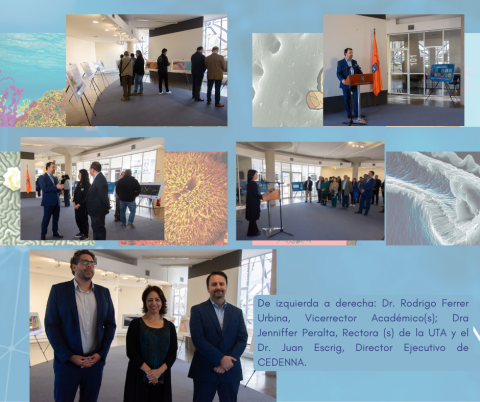
On September 28, the Exhibition "Images of the Nanoworld" was inaugurated at the Saucache Campus Library (Arica) of the University of Tarapacá (UTA), which brings together 12 images of nanoparticles of various materials, captured through electron microscopy by researchers from the Nanoscience and Nanotechnology Center, CEDENNA, who then applied color and textures to amaze us with the beautiful photographs that give life to this original exhibition. From the northern gate of Chile, it begins its itinerancy through different regions of the country, bringing this scientific discipline to a diverse audience, through a playful encounter between science and art.
It will remain on display until October 15 at the Saucache Campus to then move to Iquique, to the headquarters of the University of Tarapacá there, where it will be installed until the end of that month to then move to Region V.
This exhibition seeks to generate the curiosity and interest of the public of all ages in nanotechnology, which considers applications that are developed from the new properties exhibited by materials at the nanoscale. Some applications have been around for a long time and range from sunscreen to paints with specific properties, including components in our computers and cell phones, as well as revolutionary cancer treatments.
The rector(s) of the UTA, Dr. Jenniffer Peralta, stated that "the scientific work associated with CEDENNA that is exhibited in this art exhibition makes us move from the nano to the infinite through an adventure that fuses science with art, linking the views of researchers, professionals, students and the community in general. Multidisciplinary instances like this allow us to bring the scientific world closer to children, young people and families in the regions. We are grateful to be the first station of this "We hope that university students, schoolchildren and the general public can be part of this fascinating exhibition at our headquarters in Arica and Iquique."
Art and Science together
With the mission of opening this exhibition in Arica, the executive director of CEDENNA, Dr. Juan Escrig, traveled to that city, who pointed out that this exhibition "fills us with pride because it responds to the work of many of our students, expressed to through a playful language that uses shape and color as tools, applied to real images of the nanoworld captured in our center, through electron microscopy."
He added that both science and art share a deep connection in their search for truth, beauty and understanding of the world around us. Both fields require fundamental human qualities such as curiosity, creativity, effort and dedication to flourish and enrich our understanding of reality.
"Today we celebrate and appreciate the opportunity to demonstrate that art and science can and should walk together. And on that same path, we reiterate our permanent willingness to collaborate between different institutions and disciplines with the common purpose of responding in the best way to the new challenges that humanity poses to us," he concluded.
For a decade, the Center for Nanoscience and Nanotechnology, CEDENNA, has held an annual contest among its researchers to compile artistic images of the nano world, which are used for the calendars that the center creates each year and distributes for free in educational establishments around the world. the country. A selection of these images are what give life to the exhibition, as well as a beautiful book, full of color and shapes, which includes 36 photographs collected from these contests. The book is available in digital version for anyone who requires it, free of charge, by downloading it FROM HERE
Nothing is what it seems
As we walk through the exhibition we find a spring butterfly that flies among grains of pollen; but the truth is that we are observing a porous hydrogel that contains cellulose nanofibrils used for the remediation of colored waters.
A beautiful pink jellyfish among apparent underwater rocks is not such. It is titanium dioxide (TiO2) which in its most common phase is known as rutile, with interesting optical properties described for centuries.
Another photograph shows an aggregate of tubes of vanadium oxides in different oxidations (V (5+) and V (4+)). The resemblance to a coral is striking.
Each image is accompanied by a scientific description that shows what is really behind each photograph, demonstrating the wonder that we can find in this invisible world, which through electron microscopy shows us its secrets and amazes us.
Important fact: A nanometer is equivalent to one millionth of a millimeter, which is why nanometer-sized systems can only be observed with specialized microscopy.
- Log in to post comments







